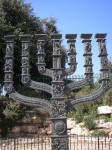Many scholars believe that the menorah is a stylized version of a tree. The Knesset Menorah, pictured here, was built by Jewish sculptor Benno Elkan, and presented to Israel by the U.K. parliament in 1956. (photo from commons.wikimedia.org)
For the winter festival of Chanukah, we will all light the candles of our chanukiyot. A chanukiyah is a menorah with an additional two candles. The eight candles (not including the shamash), we are told, represent the miracle of Chanukah, in which the oil for the Temple menorah lasted for eight days following the Maccabean victory. But what of the menorah itself? From where does it derive its form, and what does it mean?
Many scholars believe that the menorah was a stylized version of a tree. This should seem quite obvious; it is, after all, a central trunk with branches. Indeed, when first mentioned in the Book of Exodus, it is described as having branches and cups like almonds, and bearing flowers.
Sacred trees play an important role in Jewish mythology, beginning with the Trees of Life and Knowledge in the Garden of Eden. The Tanach refers to trees or wood a total of 535 times, more than any other organism other than humans. Olive trees, for instance, were important not only biblically, but to the economy of ancient Israel. The menorah was lit with olive oil. Jeremiah metaphorically describes Israel itself as an olive tree: “The Lord called thy name, a green olive tree, fair, and of goodly fruit: with the noise of a great tumult He hath kindled fire upon it, and the branches of it are broken.” (Jeremiah 11:36)
Note in the preceding passage reference not only to a branching tree, but one crowned with fire. Taking Jeremiah’s image of the burning olive tree to be a menorah, one can then conclude that the menorah is a symbol of Israel. Not that it should necessarily be considered to specifically represent an olive tree per se. Different scholars have attributed it to various trees, like the almond tree, or tamarisk, or even a special species of sage indigenous to Israel that looks strikingly similar to the menorah, and may have been used as incense by the priests of the Temple.
Many Jewish holidays involve agricultural celebration with an emphasis on arboreal reverence. One such holiday, Tu b’Shevat, also called the New Year of the Trees, takes place in late winter/early spring, around the time of the blossoming of the almond trees. Depictions of menorot found archeologically would often be accompanied by other Jewish religious symbols, such as the etrog, lulav and shofar. Their use in the autumn harvest holiday of Sukkot is described in the Tanach as follows: “And you shall take on the first day the fruit of beautiful trees, branches of palm trees, and boughs of leafy trees and willows of the brook, and you shall rejoice before the Lord your God for seven days.” (Leviticus 23:40)
It should be noted the special religious significance placed upon trees and the number seven, both of which are embodied within the menorah itself. The holidays of Sukkot and Tu b’Shevat both would have once involved pilgrimage to the Temple in Jerusalem, and be celebrated with the lighting of the menorah. These associations clearly indicate that the menorah is not only a ritualistic object, but symbolic of holidays and celebrations, bringing light into people’s lives both literally and figuratively.
The lights of the menorah are thought to have had the power to ignite the soul. Its seven lamps could be representative of the seven days of Creation. When Adam and Eve were banished from the Garden of Eden, God created a magical fire to protect the way to the Tree of Life, which perhaps also has some significance to the symbolism of the fires atop the menorah “tree.” The prophet Zechariah supposedly had a vision in which God had seven eyes that wandered through heaven. Some scholars have speculated that the seven lights in that vision, and the seven lights of the menorah, are in fact symbolic of the seven planets of classical astronomy. Some rabbis believe that the shamash represents the sun, and the first day of Creation. In the story of Genesis, on the first day, God created light. The first verse of Genesis is, in fact, composed of seven words, in Hebrew, which translate as: “In the beginning God created the heaven and the earth.” (Genesis 1:1)
The early analytical psychologist Carl Jung noted that the menorah is a synthesis of the antagonistic symbols of the tree/growth from the earth and fire/the heavens, which combine to symbolize the growth of spiritual enlightenment. Jung hypothesized that the lights of the menorah were symbolic of the illumination of consciousness. The burning bush, the way God chose to reveal himself to Moses, is thus a symbol embodied within the form of the menorah as a symbol of revelation.
Ben Leyland is an Israeli-Canadian writer, and resident of Vancouver. This article is the first of a short series examining the menorah.

